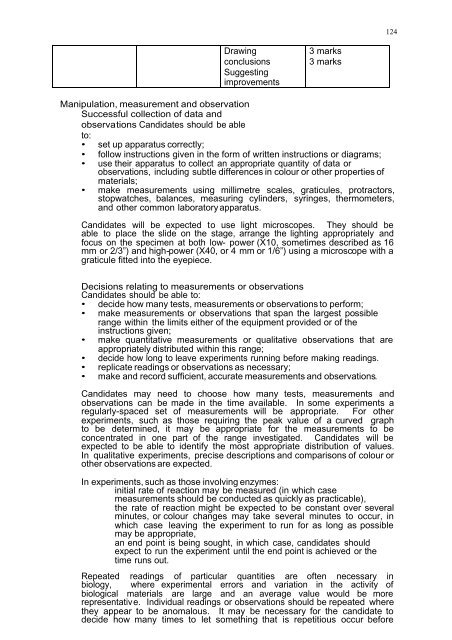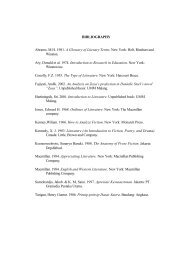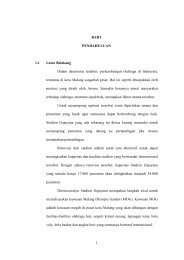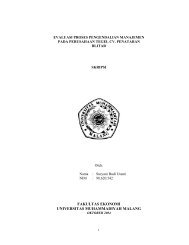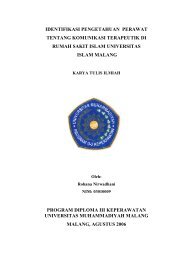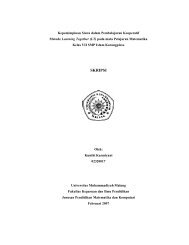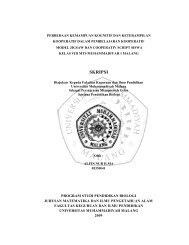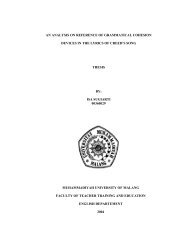File : THESIS.pdf - Universitas Muhammadiyah Malang
File : THESIS.pdf - Universitas Muhammadiyah Malang
File : THESIS.pdf - Universitas Muhammadiyah Malang
Create successful ePaper yourself
Turn your PDF publications into a flip-book with our unique Google optimized e-Paper software.
Drawing<br />
conclusions<br />
Suggesting<br />
improvements<br />
3 marks<br />
3 marks<br />
Manipulation, measurement and observation<br />
Successful collection of data and<br />
observations Candidates should be able<br />
to:<br />
• set up apparatus correctly;<br />
• follow instructions given in the form of written instructions or diagrams;<br />
• use their apparatus to collect an appropriate quantity of data or<br />
observations, including subtle differences in colour or other properties of<br />
materials;<br />
• make measurements using millimetre scales, graticules, protractors,<br />
stopwatches, balances, measuring cylinders, syringes, thermometers,<br />
and other common laboratory apparatus.<br />
Candidates will be expected to use light microscopes. They should be<br />
able to place the slide on the stage, arrange the lighting appropriately and<br />
focus on the specimen at both low- power (X10, sometimes described as 16<br />
mm or 2/3”) and high-power (X40, or 4 mm or 1/6”) using a microscope with a<br />
graticule fitted into the eyepiece.<br />
Decisions relating to measurements or observations<br />
Candidates should be able to:<br />
• decide how many tests, measurements or observations to perform;<br />
• make measurements or observations that span the largest possible<br />
range within the limits either of the equipment provided or of the<br />
instructions given;<br />
• make quantitative measurements or qualitative observations that are<br />
appropriately distributed within this range;<br />
• decide how long to leave experiments running before making readings.<br />
• replicate readings or observations as necessary;<br />
• make and record sufficient, accurate measurements and observations.<br />
Candidates may need to choose how many tests, measurements and<br />
observations can be made in the time available. In some experiments a<br />
regularly-spaced set of measurements will be appropriate. For other<br />
experiments, such as those requiring the peak value of a curved graph<br />
to be determined, it may be appropriate for the measurements to be<br />
concentrated in one part of the range investigated. Candidates will be<br />
expected to be able to identify the most appropriate distribution of values.<br />
In qualitative experiments, precise descriptions and comparisons of colour or<br />
other observations are expected.<br />
In experiments, such as those involving enzymes:<br />
initial rate of reaction may be measured (in which case<br />
measurements should be conducted as quickly as practicable),<br />
the rate of reaction might be expected to be constant over several<br />
minutes, or colour changes may take several minutes to occur, in<br />
which case leaving the experiment to run for as long as possible<br />
may be appropriate,<br />
an end point is being sought, in which case, candidates should<br />
expect to run the experiment until the end point is achieved or the<br />
time runs out.<br />
Repeated readings of particular quantities are often necessary in<br />
biology, where experimental errors and variation in the activity of<br />
biological materials are large and an average value would be more<br />
representative. Individual readings or observations should be repeated where<br />
they appear to be anomalous. It may be necessary for the candidate to<br />
decide how many times to let something that is repetitious occur before<br />
124


